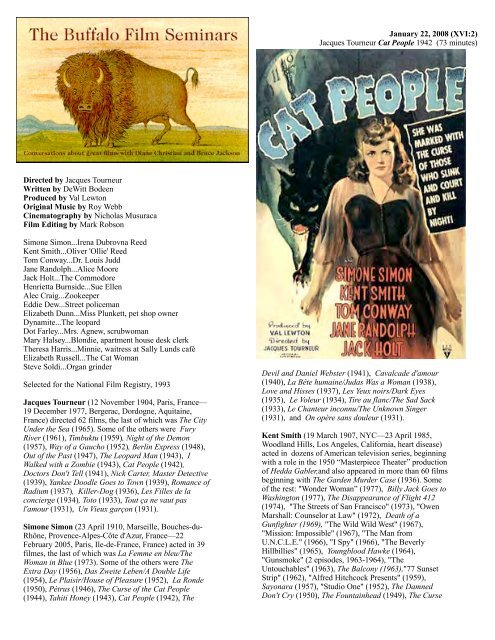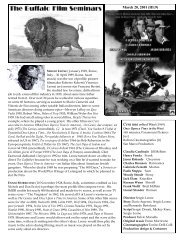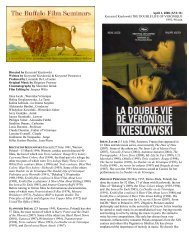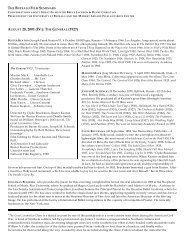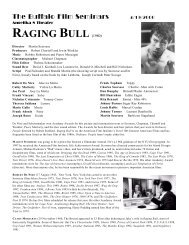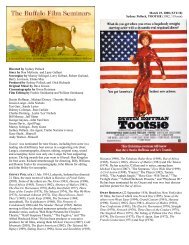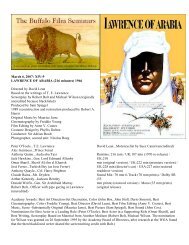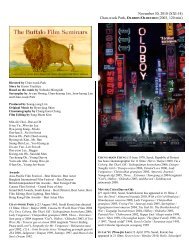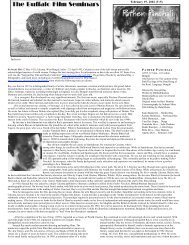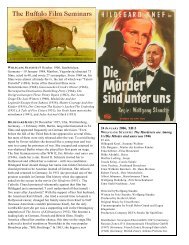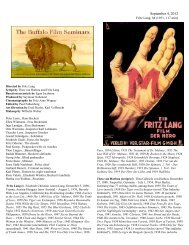Directed by Jacques Tourneur Written by DeWitt Bodeen Produced ...
Directed by Jacques Tourneur Written by DeWitt Bodeen Produced ...
Directed by Jacques Tourneur Written by DeWitt Bodeen Produced ...
Create successful ePaper yourself
Turn your PDF publications into a flip-book with our unique Google optimized e-Paper software.
Mervyn LeRoy Gold Diggers of 1933 19January 22, 2008 (XVI:2)<strong>Jacques</strong> <strong>Tourneur</strong> Cat People 1942 (73 minutes)<strong>Directed</strong> <strong>by</strong> <strong>Jacques</strong> <strong>Tourneur</strong><strong>Written</strong> <strong>by</strong> <strong>DeWitt</strong> <strong>Bodeen</strong><strong>Produced</strong> <strong>by</strong> Val LewtonOriginal Music <strong>by</strong> Roy WebbCinematography <strong>by</strong> Nicholas MusuracaFilm Editing <strong>by</strong> Mark RobsonSimone Simon...Irena Dubrovna ReedKent Smith...Oliver 'Ollie' ReedTom Conway...Dr. Louis JuddJane Randolph...Alice MooreJack Holt...The CommodoreHenrietta Burnside...Sue EllenAlec Craig...ZookeeperEddie Dew...Street policemanElizabeth Dunn...Miss Plunkett, pet shop ownerDynamite...The leopardDot Farley...Mrs. Agnew, scrubwomanMary Halsey...Blondie, apartment house desk clerkTheresa Harris...Minnie, waitress at Sally Lunds caféElizabeth Russell...The Cat WomanSteve Soldi...Organ grinderSelected for the National Film Registry, 1993<strong>Jacques</strong> <strong>Tourneur</strong> (12 November 1904, Paris, France—19 December 1977, Bergerac, Dordogne, Aquitaine,France) directed 62 films, the last of which was The CityUnder the Sea (1965). Some of the others were FuryRiver (1961), Timbuktu (1959), Night of the Demon(1957), Way of a Gaucho (1952), Berlin Express (1948),Out of the Past (1947), The Leopard Man (1943), IWalked with a Zombie (1943), Cat People (1942),Doctors Don't Tell (1941), Nick Carter, Master Detective(1939), Yankee Doodle Goes to Town (1939), Romance ofRadium (1937), Killer-Dog (1936), Les Filles de laconcierge (1934), Toto (1933), Tout ça ne vaut pasl'amour (1931), Un Vieux garçon (1931).Simone Simon (23 April 1910, Marseille, Bouches-du-Rhône, Provence-Alpes-Côte d'Azur, France—22February 2005, Paris, Ile-de-France, France) acted in 39filmes, the last of which was La Femme en bleu/TheWoman in Blue (1973). Some of the others were TheExtra Day (1956), Das Zweite Leben/A Double Life(1954), Le Plaisir/House of Pleasure (1952), La Ronde(1950), Pétrus (1946), The Curse of the Cat People(1944), Tahiti Honey (1943), Cat People (1942), TheDevil and Daniel Webster (1941), Cavalcade d'amour(1940), La Bête humaine/Judas Was a Woman (1938),Love and Hisses (1937), Les Yeux noirs/Dark Eyes(1935), Le Voleur (1934), Tire au flanc/The Sad Sack(1933), Le Chanteur inconnu/The Unknown Singer(1931), and On opère sans douleur (1931).Kent Smith (19 March 1907, NYC—23 April 1985,Woodland Hills, Los Angeles, California, heart disease)acted in dozens of American television series, beginningwith a role in the 1950 “Masterpiece Theater” productionof Hedda Gabler,and also appeared in more than 60 filmsbeginning with The Garden Murder Case (1936). Someof the rest: "Wonder Woman” (1977), Billy Jack Goes toWashington (1977), The Disappearance of Flight 412(1974), "The Streets of San Francisco" (1973), "OwenMarshall: Counselor at Law" (1972), Death of aGunfighter (1969), "The Wild Wild West" (1967),"Mission: Impossible" (1967), "The Man fromU.N.C.L.E." (1966), "I Spy" (1966), "The BeverlyHillbillies" (1965), Youngblood Hawke (1964),"Gunsmoke" (2 episodes, 1963-1964), "TheUntouchables" (1963), The Balcony (1963),"77 SunsetStrip" (1962), "Alfred Hitchcock Presents" (1959),Sayonara (1957), "Studio One" (1952), The DamnedDon't Cry (1950), The Fountainhead (1949), The Curse
<strong>Jacques</strong>—Cat People—2of the Cat People (1944), Hitler's Children (1943), CatPeople (1942) and Back Door to Heaven (1939).Tom Conway (Tom Sanders, 15 September 1904, St.Petersburg, Russia—22 April 1967, Culver City, LosAngeles, California, cirrhosis of the liver) appeared inabout 60 films and dozens of tv shows, but he wasperhaps best known for being George Sanders’ brotherand for his 10 appearances as his brother’s replacementin the RKO B-movie Falcon series, beginning with TheFalcon’s Brother (1942) and ending nine films later withThe Falcon’s Adventure (1946). Some of his otherappearances were in "Perry Mason" (1964), "Have Gun -Will Travel" (1961),"Rawhide" (1959),"Cheyenne" (1957), Operation Murder (1957), Death ofa Scoundrel (1956), Prince Valiant (1954), Tarzan andthe She-Devil (1953), Bride of the Gorilla (1951), OneTouch of Venus (1948), I Walked with a Zombie (1943),Cat People (1942), Mr. and Mrs. North (1942), Tarzan'sSecret Treasure (1941), The People vs. Dr. Kildare(1941), and The Great Meddler (1940).Val Lewton (Vladimir Leventon, 7 May 1904, Yalta,Russia—14 March 1951, Los Angeles, heart attack)produced 13 films in addition to Cat People: ApacheDrums 1951, Please Believe Me 1950, My Own TrueLove 1949, Bedlam 1946, Isle of the Dead 1945, TheBody Snatcher 1945, Youth Runs Wild 1944, The Curseof the Cat People 1944, Mademoiselle Fifi 1944, TheGhost Ship 1943, The Seventh Victim 1943, The LeopardMan 1943, and I Walked with a Zombie 1943.<strong>Jacques</strong> <strong>Tourneur</strong>from World Film Directors V.I. Ed. John Wakeman. The H.W.Wilson Company, NY 1987<strong>Jacques</strong> <strong>Tourneur</strong> (November 12,1904-December 19, 1977),American director, was born in Paris, the son of Maurice Thomas,better known as Maurice <strong>Tourneur</strong>. Originally an artist, the elder<strong>Tourneur</strong> adopted his pseudonym when he became a stage actorand director, and retained it when he joined the film productioncompany Eclair. His wife, and <strong>Jacques</strong> Touneur’s mother, wasFernande Petit, herself an actress who worked as Fernande VanDoren.With characteristic understatement, <strong>Tourneur</strong> describedhis childhood as “rather tough.” His father was an aesthete and asolitary, cynical and sarcastic. <strong>Jacques</strong> <strong>Tourneur</strong>’s “firstconfrontation with fear came in his father’s studio on ChristmasEve when he was four. His parents had put his gifts in a “hugemysterious room” and told him that he must go alone to see them:“There was a long corridor, pitch dark, and in the distance I couldsee the white shapes of my presents. I went all on my own, tornbetween my desire for the toys and a fear which nearly paralyzedme.”On other occasions, if he misbehaved, his parents “wouldput the maid in the cupboard and she used to jiggle a bowler hatwhile my parents would tell me: ‘That’s the terribleThunderman.’” <strong>Tourneur</strong> believed that this grotesque punishmentwas the root of one of his cinematic obsessions: “to suddenlyintroduce something inexplicable into the shot, such as, forinstance, the hand on the balustrade...in Curse of the Demon; inthe reverse shot the hand isn’t there any more.”In 1914 Maurice <strong>Tourneur</strong> went to Fort Lee, New Jersey,to take charge of the small studio Eclair had built there. He senthis son “to a school which happened to be in the poorer section oftown. The other kids were very violent and, as I was a foreignerwho couldn’t speak their language, I got into some stickysituations. But I learned very quickly….I was the only kid whowore suspenders. My father insisted on that, and the other kidswere always pulling on them, very hard, and then they would letthem snap against my back. After a while, I had to walk holdingup my trousers myself. I think this is what prompted me tointroduce comic touches into the dramatic moments of myfilms….Mixing fear and the ridiculous can be very exciting.”According to <strong>Jacques</strong> <strong>Tourneur</strong>, his father “waspassionately interested in scientific, medical and philosophicresearch. He had an incredible library and followed all thediscoveries in psychoanalysis very closely. It is through him that Idiscovered Freud, Jung, Adler, Havelock Ellis.I never read novels,only essays, scientific works. They are much more exciting. I wasalready fascinated <strong>by</strong> the cinema and my father bought story ideasfrom me for ten dollars apiece. At that time he was a veryimportant filmmaker in America.”Indeed, <strong>by</strong> the end of World War I, Maurice <strong>Tourneur</strong>was head of his own production company and generally regardedas the great aesthetician of the American cinema. In 1918 hemoved his company to Hollywood, where the following year<strong>Jacques</strong> <strong>Tourneur</strong> became an American citizen. In 1922 <strong>Jacques</strong>appeared as an extra in Rex Ingram’s Scaramouche, and in 1924,finishing high school, he went to MGM as a script clerk. Heworked in the same capacity for his father in 1925-1926, but inthe latter year Maurice <strong>Tourneur</strong>, whose Hollywood career was indecline, returned to Europe. He left his son a hundred dollar billand the suggestion that he try and make it to Europe himself.<strong>Jacques</strong> <strong>Tourneur</strong> did not at first take advantage of thisoffer, instead finding odd jobs in Hollywood as an actor and usher.But in 1927 his father invited him to Germany to work on DasSchiff der verloren Menschen (Ship of Lost Men), and this time hewent. He served as his father’s editor and assistant on this filmand then on a series of talkies made in Paris for Pathe-Nathan in1929-1934. It was during this period that <strong>Jacques</strong> <strong>Tourneur</strong>directed his own first movies for the same company, beginning in1931 with Tout ça ne vaut pas l’amour (None of That’s WorthLove).In an interview with Bertrand Tavernier in Positif(November 1971), translated in Johnston and Willemen’s <strong>Jacques</strong><strong>Tourneur</strong> (1975), the director said that in his own opinion the bestof his four French films was Les Filles de la concierge (TheConcierge’s Daughters, 1934)–“a little comedy [inspired <strong>by</strong>Unanimism], it was realistic, giving a fairly accurate portrait of asocial milieu. It had many comic elements, especially for thattime. The other films weren’t very good, at least not as far as I canremember.”In 1934 <strong>Tourneur</strong> broke away from his father andreturned to Hollywood. He directed sequences in CharlesRiesner’s The Winning Ticket and Jack Conway’s A Tale of TwoCities, and in 1936-1938 made a whole series of one-reelers forMGM. The following year he directed his first American feature,They All Came Out, and there were three more B-pictures in1939-1941, two of them starring Walter Pidgeon as the “masterdetective” Nick Carter.<strong>Tourneur</strong> had worked with Val Lewton on the crowdscenes in A Tale of Two Cities, and in 1942 he began his sevenyearassociation with RKO, where Lewton was then working as a
<strong>Jacques</strong>—Cat People—6allowing the audiences who don’t recognise the validity ofsupernatural stories to read fantastical events as symptoms of aderanged mind (cf., The Innocents, 1961)–but subtlety. Lewtondecreed: “We tossed away the horror formula right from thebeginning. No grisly stuff for us. No mask-like faces hardlyhuman, with gnashing teeth and hair standing on end. No creakingphysical manifestations. No horror piled on horror. You can’t keepup horror that’s long sustained. Itbecomes something to laugh at. Buttake a sweet love story, or a story ofsexual antagonisms, about peoplelike the rest of us, not freaks, and cutin your horror here and there <strong>by</strong>suggestion, and you’ve gotsomething. Anyhow, we think youhave. That’s the way to do it.”…Though Irena never sportsyak-hair and fangs, Cat People isunambiguous about her status: thefilm’s last line (‘she never lied tous’), along with details liketransforming footprints and ashredded bathrobe, prove that Irenareally is a Cat Person. Dr Juddinterprets what she tells him as achildhood trauma, but we are supposed to understand what reallyhappened before Irena was born: her father made love to hermother in the forest, impregnating her, and she transformed into apanther and killed him. The lesson is not that a psychologicalstudy is more worthy than a cat werewolf movie, but that a horrorfilm can have psychological depth. That Irena is a cat persondoesn’t make the film any less affecting as the story of a troubledmarriage….The ‘bus’ [which stops so Alice can evade her pursuer] isa punchline, but the stalking sequence is the set-up, anddemonstrates the quality for which Lewton’s horror films werefamous: darkness. In an interview, Lewton boasted ‘I’ll tell you asecret: if you make the screen dark enough, the mind’s eye willread anything into it you want! We’re great ones for dark patches.Remember the long walk alone at night in Cat People? Mostpeople swear they saw a leopard move in the hedge above her–butthey didn’t! Optical illusion; dark patch.’…Lewton decided against his planned final shot of the deadIrena as panther, but couldn’t resist a last stab at culture. The endtitle is another verse, authentic this time:But black sin hath betrayed to endless nightMy world, both parts, and both parts must die.(John Donne, Holy Sonnets, V)The production code prohibited plot resolution through suicide,but it is clear that Irena–perhaps fatally wounded <strong>by</strong> Dr Judd–hasused the panther to finish herself off, as is obliquely confirmed <strong>by</strong>the Donne passage….<strong>Tourneur</strong> always seemed to be in two minds about CatPeople; he once said Cat People was very childish but audiencesin those days were much more naive tan they are today. If youmade Cat People today exactly as we did, they’d laugh you out ofthe theatre because it was naive-a kind of joke. But there weresome very good things in it.’ On another occasion he mused, “Thepicture was made during the war, and during war, for somemysterious reason, people love to be frightened. Subconsciouslywe all enjoy being afraid, and in war that feeling is intensified.Wars release all our needs: young men can rape with sanction,plunder without retribution. We all love wars and love to befrightened, and in wartime people had money from the plants,money to burn, and they loved that kind of film.”Unlike Robson and Wise, he never quite became anestablishment director: even career highlights like Out of the Past(1947) and Night of the Demon were not major successes, and hefound himself stuck with too many oddball projects….Lewton’s films were recognized ontheir first release <strong>by</strong> perceptive critics likeJames Agee and Manny Farber asextraordinary <strong>by</strong> any standards, and aretreated sympathetically <strong>by</strong> the first criticalhistories of the horror film.from The Cinema of Nightfall <strong>Jacques</strong><strong>Tourneur</strong>. Chris Fujiwara. with aforeword <strong>by</strong> Martin Scorsese. The JohnsHopkins University Press. Baltimore &London, 1998Foreword <strong>by</strong> Martin Scorsese.It’s appropriate that so many of<strong>Jacques</strong> <strong>Tourneur</strong>’s movies deal with thesupernatural and the paranormal, becausehis own touch as a filmmaker is elusive yettangible, like the presence of a ghost–in away, you could say that <strong>Tourneur</strong>’s touch is so refined and subtlethat he haunts his films. It’s as though he cast a spell over eachproject, from a movie that actually deals with the supernatural likeCat People to one that only seems to deal with it, like TheLeopard Man, to a western like Canyon Passage, a period piecelike Experiment Perilous, a noir like Out of the Past or a routine Bassignment like Nick Carter, Master Detective. Which may be thereason why he remains so under appreciated. <strong>Tourneur</strong> was a greatdirector….He never made grand statements and he never workedwith large budgets or big stars. He cultivated the most fleeting andelusive aspects of experience, things that other filmmakers wouldnever bother with but that, for <strong>Tourneur</strong>, were the essence ofmovies.<strong>Tourneur</strong> was an artist of atmospheres….<strong>Tourneur</strong>’sfilms are very special to me, and they’ve been a great inspirationthroughout my career. He’s one of those directors whose workrenews your enthusiasm for movies–whenever I look at one of hisfilms on tape or on screen, I remember why I wanted to makemovies in the first place. The craft, taste, and extraordinary fluidartistry of his cinema make most other movies look bloated andsynthetic....<strong>Tourneur</strong>’s achievement remains underappreciated andmisunderstood. His films are mostly relatively obscure thrillers.Westerns, and adventure films that, at first glance, have little incommon. Of the five best-known films he directed, three of them–Cat People, I Walked with a Zombie, and The Leopard Man–aremore often credited to their producer, Val Lewton, than to thedirector, whereas the other two, Out of the Past and Night of theDemon (as it is known in Britain where it was produced; in theUnited States it was released as Curse of the Demon), tend to bepraised as quintessential genre pieces rather than as personalworks….<strong>Tourneur</strong>’s “themes” are conceptual oppositions betweenwhose terms his characters seek to define themselves, boundariesthat are simultaneously or fluctuatingly real, imaginary, and
<strong>Jacques</strong>—Cat People—7symbolic: the boundaries between human and animal (Cat People,The Leopard Man), between living and dead (I Walked with aZombie), between health/sanity and sickness/insanity (“The MagicAlphabet,” Cat People, Experiment Perilous, Easy Living, Stars inMy Crown), between town and wilderness or open country (theWesterns, Way of a Gaucho), between law and crime (Out of thePast, Nightfall), between male and female (Anne of the Indies),and “between the powers of darkness and the powers of themind” (Night of the Demon). <strong>Tourneur</strong>’s special territory is thespace between these poles. As Paul Willemen writes, “Althoughthe films dramatise the conflict between terms A/B, it is the ‘/’which constitutes the enigmatic pivot upon which <strong>Tourneur</strong>’sfilms turn.The typical <strong>Tourneur</strong> narrative is full of confusion andambiguity, signs that point in no clear direction, and messages thatcircle back on the sender. The director’s narrative and stylisticchoices constantly underline absence and distance….Himself a figure at the crossroads of two worlds, hisnative Europe and his adoptive home America, <strong>Tourneur</strong>persistently explores in his films the antagonisms andmisunderstandings that arise from cultural difference. …<strong>Tourneur</strong> was one of several European directors who,working in Hollywood during the 1940s, evolved an alternative(some might argue, oppositional) film practice. In order of theirfirst American feature directing credits, they include Elgar G.Ulmer, Fritz Lang, Otto Preminger, <strong>Tourneur</strong>, Billy Wilder, JeanRenoir, Robert Siodmak, Douglas Sirk, and Andre De Toth. Thegroup members share several characteristics: they almost allstarted directing in Hollywood in the late 1930s or early 1940s(Ulmer, the exception, directed his first American film in 1932);they all have an affinity for what has become known as film noir;and many of them express a politically liberal viewpoint in theirfilms. The liberalism of Lang, Renoir, Preminger, and Sirk isexplicit. That of <strong>Tourneur</strong> is less definite but no less perceptible:the liberalism of Berlin Express probably owes more to itsproducer, Bert Granet, than to its director, but the sympathetictreatment of blacks and other minorities throughout <strong>Tourneur</strong>’sfilms is a clear-enough sign of the director’s attitude….The cutting in <strong>Tourneur</strong>’s films gives a sense ofdislocation and disorientation to spaces that characters inhabitprecariously….<strong>Tourneur</strong>’s sound practice represents a deliberateattempt to make use of an often neglected potential of the filmmedium. Frequently in <strong>Tourneur</strong> films, off-screen sounds disruptthe images, accentuating the instability of the narratives….<strong>Tourneur</strong>’s cinema, obsessed with the unshowable andwith the conditions of its own impossibility, is the antithesis of thecinema of spectacle.Asked in 1977, a few months before he died, what placehe thought his films had in the history of cinema, <strong>Jacques</strong><strong>Tourneur</strong> replied:”None. Nothing is more evanescent than animage in celluloid….I’m a very average director. I did my workthe best I could, we’re all limited. On the one hand, one shouldn’thave false modesty; on the other, one shouldn’t seem to boast; I’msomewhere between the two.”<strong>Tourneur</strong>’s willingness to consign himself and his worksto oblivion is typical of him. Throughout his career he was a softspoken,self-effacing artisan; later he was happy to tellinterviewers that he never turned down a script. That he was farform an “average” director, however, is apparent from his films(several of which, despite his own final assessment, are likely toendure as long as the cinema) but also from his interviews, whichinvariably betray the concerns and the point of view of a selfconscious,precise artist.The 1977 interview was conducted in French; the word“average” is an unavoidable (in context) translation for a word,moyen, that has other meanings more appropriate to <strong>Tourneur</strong>’sachievement. Moyen also means “middle” or “medium”–wordsclosely related (like the phrase “somewhere between the two”)both to themes of thresholds, borders, and transformations that<strong>Tourneur</strong> treated consistently in his films and to his view of hisown role as an artist, a role that he saw as similar to that of amedium. “You must be more modest, try to handle as well aspossible what you are given and let your subconsciouswork….This attitude forces you to be open, receptive to allgenres, to all forms of narration. It’s a way of refusing tospecialize.”<strong>Tourneur</strong>’s insistence on the “evanescent” nature of filmis also significant, since his work is so preoccupied with, and sobrilliant at tracing, the invisible and the absent. His films not onlyembrace their own obscurity and the risk of their disappearancebut seem to make these the conditions of their existence.<strong>Tourneur</strong>’s cinema, though remaining the most “average” ofHollywood cinemas, also finds the most elusive way imaginableof dispersing the limits that Hollywood imposed onrepresentation.Cat People derives its situations, including its horrificones, from the emotions of the protagonists, a tactic that sets itapart from the typical horror cinema of the time. The main tensionin the film comes from Irena’s fear of her own sexuality as “evil”-a daring choice of theme for 1942….The most famous of the many ellipses in the film is therefusal to show the transformation of Irena into a cat. This refusalleaves a number of traces in the film….Cat People is so famous that it has ,inevitably, suffered abacklash, and now it might even be called underrated….Cat People remains, with all its flaws, a perfect filmwhichmeans that even its flaws have become classic.Afterword
<strong>Jacques</strong>—Cat People—8COMING UP IN THE SPRING 2008 SERIES:Jan 29 Irving Rapper NOW,VOYAGER (1942)Feb 5 Billy Wilder ACE IN THE HOLE (1951)Feb 12 Billy Wilder WITNESS FOR THE PROSECUTION(1957)Feb 19 François Truffaut 400 BLOWS (1959)Feb 26 Masaki Kobayashi HARA KIRI (1962)Mar 4 Robert Altman MCCABE & MRS. MILLER (1971)*Mar 18 Hal Ash<strong>by</strong> BEING THERE (1982)*Mar 25 Sydney Pollack TOOTSIE (1982)Apr 1 Krzysztof Kieslowski THE DOUBLE LIFE OFVERONIQUE (1991)Apr 8 Jane Campion THE PIANO (1993)Apr 15 Clint Eastwood UNFORGIVEN (1992)Apr 22 Ingmar Bergman THE SEVENTH SEAL (1957)CONTACTS:...email Diane Christian: engdc@buffalo.edu…email Bruce Jackson bjackson@buffalo.edu...for the series schedule, annotations, links and updates: http://buffalofilmseminars.com...to subscribe to the weekly email informational notes, send an email to mailto :addto list@buffalofilmseminars.com....for cast and crew info on any film: http://imdb.com/The Buffalo Film Seminars are presented <strong>by</strong> the Market Arcade Film & Arts Centerand State University of New York at Buffalowith support from the Robert and Patricia Col<strong>by</strong> Foundation


